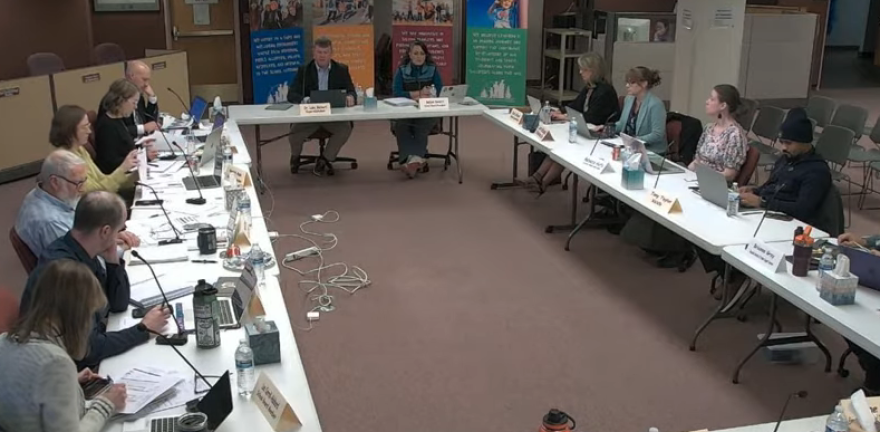Administrators for Fairbanks area public schools say a new charter school would cost the district about $2 million more than the committee proposing it estimates.
The disagreement comes roughly a week after the Academic Policy Committee for the Pearl Creek STEAM Charter School held a Q&A session with the Fairbanks North Star Borough School District’s Board of Education.
Pearl Creek Elementary is one of three former neighborhood schools the board voted to close in February as a cost-saving and downsizing measure. The proposed charter school’s committee hopes to use that building and says they’re in lease negotiations with the borough. They’re aiming to begin operations by next school year.
The school board is tasked with voting on whether to approve the committee’s application for the proposed school, which was submitted in August.
Last week, the committee’s presentation projected that, if it opens, the new charter would have a net cost to the school district of about $830,000. But district Chief Operations Officer Andy DeGraw said at a work session this Tuesday that their number is off. He said the new school would shake out to a net cost to the district of about $2.8 million for the next fiscal year and hover around the same amount in years to follow. Budgetarily, if offset by changes to the district's pupil-to-teacher ratio, that would equate to a classroom size increase of about two students districtwide, according to the administration's presentation.
“The numbers are not subjective in nature. It’s not a situation to where, if we look at them differently, or if we have a different perspective, or if we crunch the numbers differently, they’re going to materially change,” DeGraw said. “The numbers aren’t nuanced. They are what they are, and they’re objective in nature.”
As the main expense, the school district’s calculation considers the annual payment the district must send to a public charter school. Charter schools use that sum to run their programs with a degree of self-governance that separates them from neighborhood schools.
The charter allocation is primarily made up of money the district receives from state per-student funding, which then gets passed on to the charter school in proportion to its enrollment. A smaller amount of the allocation comes from the local funding the district receives from the borough.
DeGraw said, based on the proposed school’s first-year target of about 350 students, the district would need to allocate about $3.8 million to Pearl Creek. But he said 350 students moving from neighborhood schools to the charter school wouldn’t translate to the same amount of savings for the district. That’s because building-related costs are fixed, and many minimum personnel needs wouldn’t change at the schools the Pearl Creek students would be moving from, he said.
DeGraw said, if the proposed school’s application were approved, the only notable savings for the district would come from needing an estimated eight fewer classroom teachers. According to his calculations, that would translate to about a $1 million decrease in district expenditures, meaning new costs would outweigh the new savings by the $2.8 million figure.
“We know what’s going to happen almost before it happens. We do – because we’ve seen it before. We’ve seen the exact same scenarios play out each time a new charter gets stood up,” DeGraw said.
The district currently has five charter schools, with enrollments varying from about 140 to 200, meaning Pearl Creek, which projects multi-year growth to the tune of about 470 students total, would become the largest. The last charter school to open in FNSBSD was Discovery Peak, in North Pole, during the 2019-2020 school year.
Beyond impacts to the district’s budget, school board members largely repeated concerns about the Pearl Creek application that they’d raised during last week’s session.
Their comments included worries about the legality of the school’s proposed tiered lottery system for admissions, which favors former Pearl Creek students and children of staff as well as children and grandchildren of “founding members” in the event of oversubscription.
"I do not see this being a choice for all. What I see this being is a choice for the families of that community — possibly grandchildren of that community — and then, maybe, if there's room, then the rest of 'all,'" said Board President Melissa Burnett.
Alaska law for charter school admissions says that “[i]f it is not possible to accommodate all eligible students who submit a timely application, students shall be accepted by random drawing,” though last week, APC members said they sought legal advice on their proposed system.
Multiple school board members expressed skepticism Tuesday about how realistic the committee’s budget assumptions are for its own operating expenses, like furnishing rooms, purchasing textbooks, and buying technology for students and teachers. Board member Loa Carroll-Hubbard also pointed out that the sum of expenses in the operating budget that’s part of the application appears to fail to add in the principal’s salary, a $192,000 cost.
“So between all these small things, I think we’re adding up to a pretty monumental group of, I don’t know, I guess errors, or just miscalculations,” Carroll-Hubbard said.
The board has signaled that they plan to vote on the application at their regular meeting next Tuesday, though an agenda for that meeting had not been posted as of Wednesday night.


